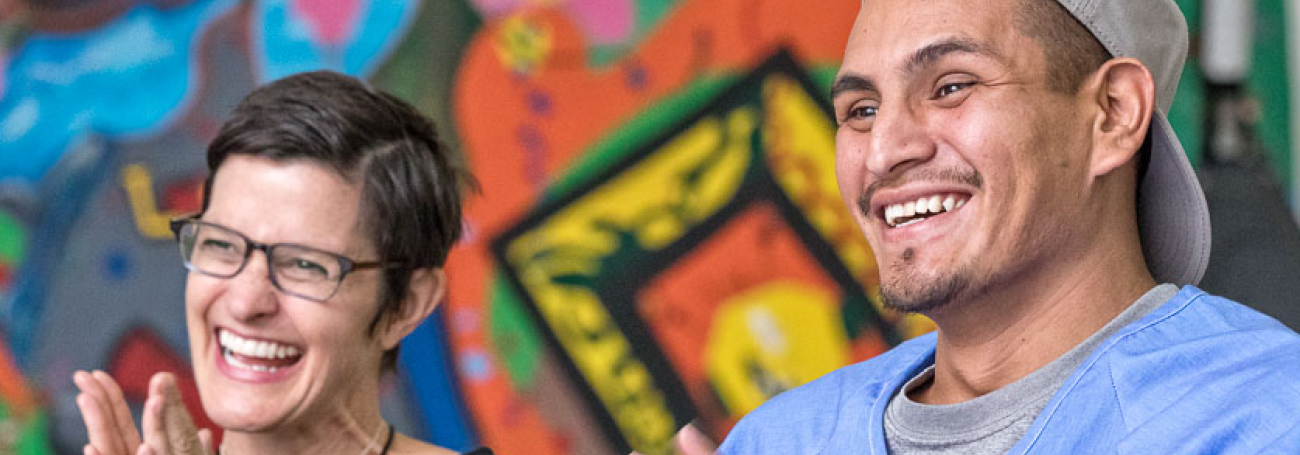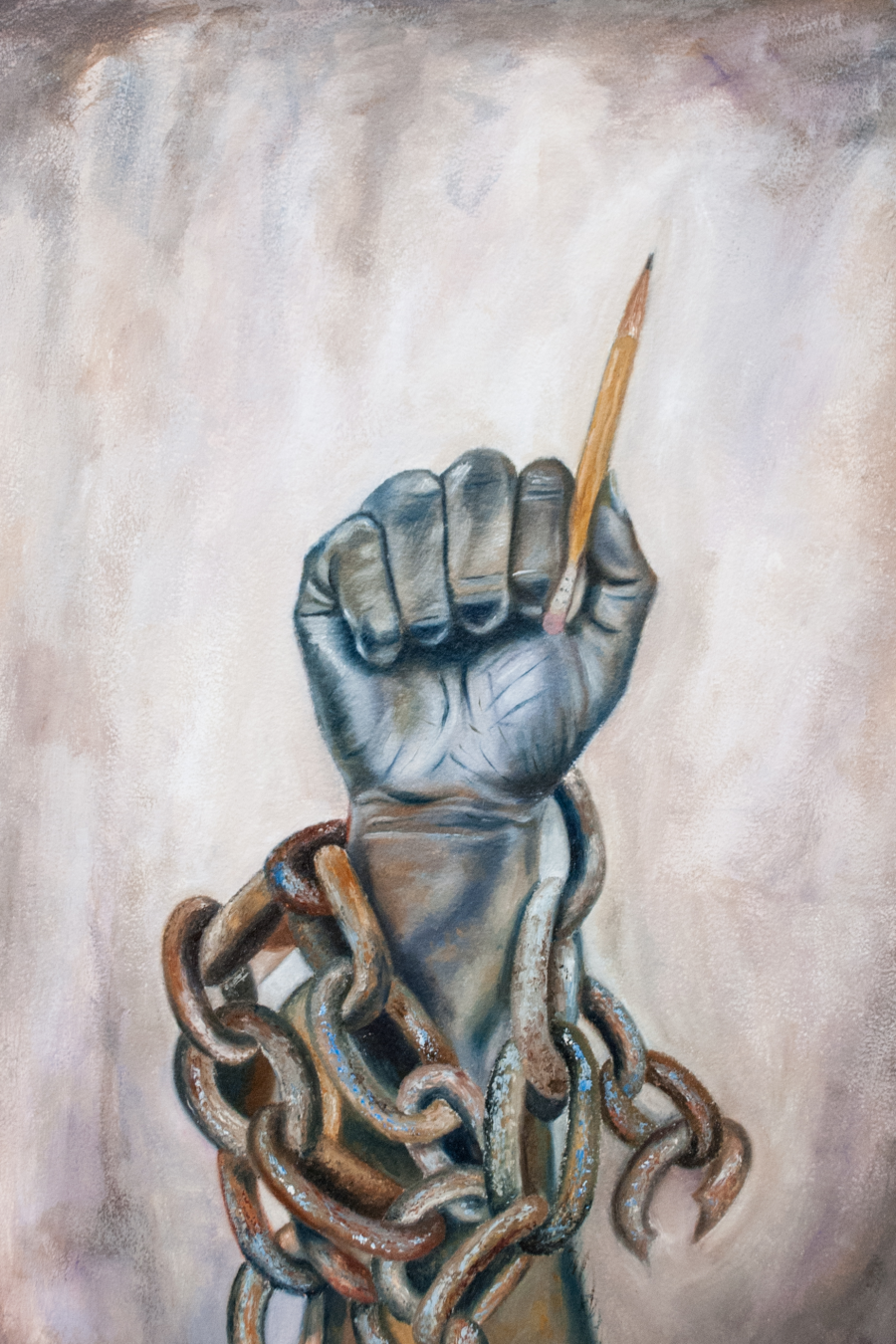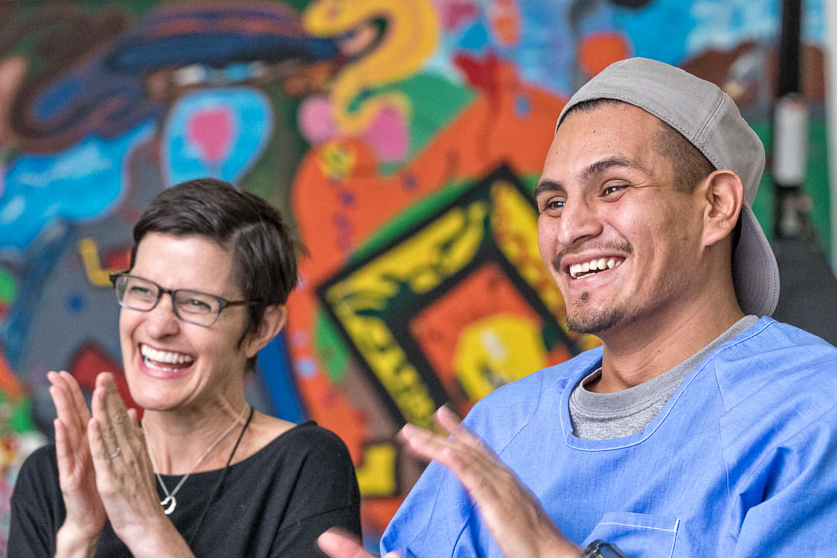
"Painting takes my mind off being in prison. It makes me feel beautiful."
— PAC participant

"Painting takes my mind off being in prison. It makes me feel beautiful."
— PAC participant
In comparison to the correctional landscape in most of Europe, American prisons have generally acquired the reputation of spaces where the emphasis is on punitiveness rather than rehabilitation. This is not to convey that rehabilitative efforts do not exist in America; however, America’s relationship with rehabilitation has been complicated. The tough-on-crime policies of the 1970s — and decision makers who promoted them to appease voters and alleviate the public’s fear of crime — led to an enormous number of people continuously being sentenced to serve time in prison, often for decades and sometimes with multiple life sentences. Complicating the situation further, people sentenced to prison have disproportionately come from communities of colour and economically disadvantaged communities.
Historically, Black men’s likelihood to be incarcerated far surpasses the odds for men of other racial and ethnic backgrounds (Gramlich, 2020). Black men are five times more likely to go to prison than white men specifically (Nellis, 2021). Mass incarceration and systemic racism quickly became staples of the US criminal justice system’s vocabulary. As of 2023, almost 2 million people are incarcerated in America, making it one of the nations with the highest incarceration rates (Sawyer and Wagner, 2023). Since the majority of people who are currently behind bars will be eventually released, the utmost importance of offering programming that would address the searing rates of recidivism cannot be overstated. The need for meaningful rehabilitation is pressing.
Nevertheless, in 1974, Robert Martinson, an American sociologist focusing on criminology, famously concluded that rehabilitative programming in prisons did not work. Martinson’s work was well received by correctional decision makers and substantially contributed to doubling down on punitiveness. Despite the shortcomings of the methods of studies that Martinson reviewed, and his own perspectives on what he found, rehabilitation remains questioned to this day. Fortunately, the study of correctional programming has tremendously progressed since the 1970s, and we now know what type of programming works and what does not. Evidence-based programmes are at the forefront in the field.
As of 2023, Crime Solutions under the National Institute of Justice reports that 170 programmes in the area of corrections and re-entry across the US are effective in achieving their intended outcomes as evidenced by data. While evidence-based correctional practices are the pinnacle of addressing individuals’ criminogenic needs (Andrews and Bonta, 2010), the benefits of arts-based programming are relatively unexplored even though they tap directly into at least one criminogenic need — leisure time — and further can be connected to the Good Lives Model (Ward, 2002). To briefly elaborate, the Good Lives Model posits that rehabilitation also includes focus on fulfilling one’s innate need to lead a meaningful life.
Most of the people in prison carry a history of trauma, and their likelihood of experiencing more while they are incarcerated is searing (Widra, 2020; Sawyer and Wagner, 2023). This is also true in California where the correctional landscape is additionally highly affected by the aforementioned harsh sentencing policies (e.g. three-strikes law) and long sentences, high recidivism rate, and strict racial divides that exist in the prisons to this day. To many who are incarcerated in the state, it is unthinkable to share space and heal alongside individuals from different racial backgrounds. The nuances that complicate lives, rehabilitation and re-entry of incarcerated individuals in California are countless. Noting these nuances, the state is increasingly attempting to become more responsive to the needs of system-impacted people. For example, a recently passed Assembly Bill 1104 is to ensure that rehabilitation becomes one of the pillars of California corrections. Rehabilitative programming has been extensively available in the state’s prisons even prior to AB 1104. One example is arts-based programming provided by Prison Arts Collective (PAC). Since 2013, Prison Arts Collective has been dedicated to expanding the transformative power of the arts to communities impacted by incarceration. The project and collaborative teaching teams are organised around the belief in art as a human right.
Art is essential in human development and allows the artist to use their personal experience as the energy for the artist. Art will continue to be an integral part of rehabilitation ’cause it causes the person to search within in order to create their own personal artwork.
— PAC participant

A group of about twelve men in blue uniforms, the words ‘CDCR Prisoner’ emblazoned on the backs of their shirts in yellow block letters, sit in a circle at the back of a large, bare prison gym at the conclusion of a yoga class. Around the spare cement floor, two additional gatherings of men are engaged in creative arts with teachers from the local university. A similar setting takes place across fourteen prisons in California where PAC offers collaborative and multidisciplinary arts programming. Since starting with one university-based team of faculty and students at one prison in 2013, we have brought arts programming to more than 7,000 people incarcerated in California state prisons with the support of state and federal grant funding. But on this day, in this gym, the men engaged in class with an enthusiastic team of teaching artists focused on making art and building a creative community.
Each PAC class follows a four-part model including:
Image: M. Nguyen: My Choice of Weapon
The four elements of a PAC class are designed to create an experience that allows for creativity and expression while also making space for dialogue, interaction, and insight. Art history is introduced to let participants know that they are part of a larger story and to inspire new ideas. Reflection and dialogue facilitate community building and the rare (in prison) opportunity to express feelings and listen thoughtfully to a point of view that might be vastly different from one’s own experience.
This process takes place in one of the most restrictive spaces imaginable, both from the outside (bars, locks, cells, tightly controlled movement), and from the inside (most American prisons operate along strict racial divides imposed by the residents themselves). It provides a level of freedom and imagination not present in the regular prison environment. In addition, art and other rehabilitative classes are spaces where residents can interact with folks they would not talk to on the yard for fear of retaliation by those that uphold the strict if unwritten codes of order. Thus, the art spaces in PAC classes, and in the many rehabilitative programmes throughout California, are active spaces of integration — of thought, ideas, experiences, people — and resistance to the steady control of one’s ideas and movement and friends. Art, in this sense, is liberation. It is art at its most elemental and vital.
I am interested in the ways art can be used as a tool for healing and liberation. I am interested in the ways artists can leverage their resources and privilege to create access points for other members in their communities.
— PAC intern

Photo: student with family. Image by Peter Merts, January 2023
Back in the prison gym, a professor that had recently curated an exhibition of the men’s work outside the walls was visiting for the day. A participant en route from yoga warm up to painting class approached her and asked to speak briefly. ‘You know the book you gave us?’ he began, referencing a publication the team had created alongside the exhibition.
‘Yes, I remember. Did you get your copy?’ She asked.
‘Yes!’ He began, then halted, enthusiastic but also shy, in the manner often seen in people experiencing the deeply institutionalised life of American prisons. She waited, nodding encouragingly, knowing he had something more to share and allowing space.
‘I sent it to my family,’ he said with cautious pride and an irrepressible smile, ‘My daughter, you know what she told her friends? She told them that her dad is an artist.’
The professor broke out in a grin. ‘That is beautiful,’ she said softly, ‘Thank you for sharing.’ And the man walked a few paces to the PAC class led by a graduate student.
I think this class is a wonderful opportunity to learn and bring out something positive out of us. This class has helped me with my rehabilitation in many ways. For example, meditation, relaxation, how to learn the different types of art, how to use and blend paint. But, overall, is how to bring out my hidden talent I didn’t know I had.
— PAC participant
Art can be so many things to so many people. But here, in the most restrictive of spaces possible, the impact of art shines in high relief. Art offers liberation in a space where freedom is denied. Art offers a means to express the feelings that are too tangled or tough for words. The art class provides a place to relax in an environment where most live under 24/7 stressors. All of these are vital not only for a meaningful life (see Ward (2002) for a discussion on why that is important in the context of the Good Lives Model), but for wellness and, arguably, for survival.
The particular set up of PAC classes intentionally builds on the transformative power of art to allow participants to also gain opportunities for dialogue and community building, self awareness and identity building, and a vital expanding of perspective. For people that often lack any opportunity to connect with others outside of this limited space, or the chance to see or experience a walk on the beach, a picnic with family, even, in many cases, a view through a window, the impact of a creative community in which to connect with others is profound. It is the significance of connection that brings us to the concept of restorative justice.
Restorative justice centres on the needs of the person who was victimised, arguing that the traditional approach to justice overly focuses on punishment rather than on repairing the harm that has been done (Zehr, 1990). The emphasis is also put on the community and the person who committed the crime. Although the work that PAC engages in does not directly contribute to the wellbeing of those who were victimised, positioning arts-based programming as a tool for restorative justice is not far-fetched. Incarcerated people coming together to create art and sharing it (through gifting, donating, displaying) with one another, with their community, with their loved ones can undoubtedly be a way to start mending relationships. But this conceptualisation is up for debate, even among the people that PAC serves.
Art for me is much more than putting brush to canvas, it was about connecting with others and developing a sense of belonging. It was about learning to express myself emotionally, artistically and vocally, as well as listen to others in a more meaningful way.
— PAC participant

At the furthest edge of California, deep in the heart of a remote landscape, behind numerous locked gates and steel walls, a professor and a group of students in prison blues sit together in a crowded classroom. On the walls, oversized post-it notes feature comments from their conversation in brightly coloured and varied handwriting, as everyone takes turns jotting notes. The topic of the day is how art does or does not further restorative justice.
Photo: Professor Annie Buckley and participant. Image by Peter Merts, June 2017
The students are enrolled in a training class unique to PAC. It was designed for people with experience in the arts who want to share it and for correctional institutions that are far from cities where they might get more frequent volunteers. The Arts Facilitator Training is a 60 hour course followed by 10–15 weeks of apprenticeship. At the conclusion of this, the peer facilitators lead classes and cultivate creative communities with the prisons with mentorship and supplies from PAC. While learning to teach, participants study art history, classroom management, lesson planning, and practice standing up in front of others to speak and facilitate dialogue with a group of peers. This training has resulted in over 400 people graduating and 29 currently teaching classes in state prisons across California. Of those who took this programme and have been released, several work in re-entry spaces, including PAC. Over the years, PAC has hired approximately ten alumni from this programme in different capacities including as interns, teaching artists and coordinators.
Initially, the professor asks if anyone knows what restorative justice means. A few hands go up but most stay down. She calls on someone who shares what he learned about restorative justice in another rehabilitative group. Others slowly build on the answer and they come to a working definition, noting that the process of restorative justice emphasises community health over individual blame and, crucially, engages the victims of crimes in restorative dialogue. Some participants have taken part in groups that actively engage this dialogic process, but many have not and, for a majority, the concept of restorative is new.
As a next step, the group discusses how art does or does not forward restorative justice. Several participants enthusiastically note the ways that art does forward restorative justice, as a means of liberation, reflection and growing understanding for the artists and as a way to share something positive with the world. The students are actively engaged in stating the many benefits that art has on their rehabilitation when someone raises his hand tentatively. The professor calls on him and he begins, ‘We are in here making things,’ continuing with emphasis, ‘but it is not doing anything for the victims of crime! So I don’t think it is restorative justice.’
Several hands quickly go up, eager to refute this point. Some note that they send art outside and it is sold to support charity. One explains that he sends his art home and his mother gives it away, bringing positivity to the community and shifting perceptions of those that commit crimes. The discussion continues but the man that refuted art’s engagements as restorative justice stands firm in his perspective. The fact that he can solidly defend a perspective at odds with the group is testament to the climate the professor and students have co-created that allows for respect, listening and accepting altering viewpoints. Interestingly, these are the elements that characterise, if not embody, restorative justice practices more broadly. What stands out is how firmly and passionately the men defended art as a part of restorative justice. It was as if they not only believed it was, but really needed it to be, integral to this healing process.
For those engaged in PAC and other arts programmes inside correctional institutions, art can be a vital bridge to their own freedom, transformation, selfhood, and community as well as to the outside world. For those still in touch with family and friends, it is a way to share something they have made. And for those who do not have connections to family any longer, art can open an avenue to connection to community.
The idea of ‘giving back’ is often touted as a vital part of healing for those who are incarcerated and art offers a powerful opportunity. Those inside give art to family and friends to bring happiness and joy, to show another side of them, to demonstrate their positivity and light in a dark space. And many also give art to community groups and nonprofits, including PAC, which are then given to donors or sold to raise funds for art materials, for community needs, for victims’ groups, and more.
Art might not be the main purveyor of traditional restorative justice dialogue, putting victims and perpetrators in conversation, but facilitating the creativity and imagination of the arts within correctional settings can further the goals of restorative justice, including identity building, expressing feelings, listening to alternate points of view, and connecting with others inside and out. For those locked into conditions with few to no outlets, with histories often steeped in trauma, the opportunity to engage with others in the creative community is a lifeline and a bridge.
Annie Buckley is the founder and Director of Prison Arts Collective and Founding Director of SDSU VISTA: Valuing Incarcerated Scholars through Academia. She is a Professor of Visual Studies and Director of the Institute for the Arts, Humanities, and Social Justice at San Diego State University.
Contact: ambuckley@sdsu.edu
Tereza Trejbalová is an Assistant Professor in Criminal Justice at San Diego State University and and Associate Director, Prison Arts Collective
Contact: ttrejbalova@sdsu.edu
Published on 30 December 2023.
Andrews, D.A. and Bonta, J. (2010). The psychology of criminal conduct. 5th ed. New York: Routledge.
Gramlich, J. (2020). Black imprisonment rate in the U.S. has fallen by a third since 2006. Pew Research Center.
Martinson, R. (1974). What works? — Questions and answers about prison reform. The Public Interest 35:22–54.
Nellis, A. (2021). The color of justice: racial and ethnic disparity in state prisons. Washington DC:
The Sentencing Project.
Sawyer, W. and Wagner, P. (2023). Mass incarceration: the whole pie 2023. Prison Policy Initiative.
Ward, T. (2002). The management of risk and the design of good lives. Australian Psychologist 37(3):172–179. Https://doi.org/10.1080/00050060210001706846.
Widra, E. (2020). No escape: the trauma of witnessing violence in prison. Prison Policy Initiative.
Zehr, H. (1990). Changing lenses: a new focus for crime and justice. Scottdale PA: Herald Press.
Published on 17 January 2024.